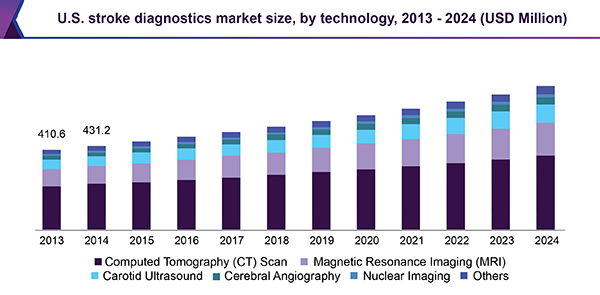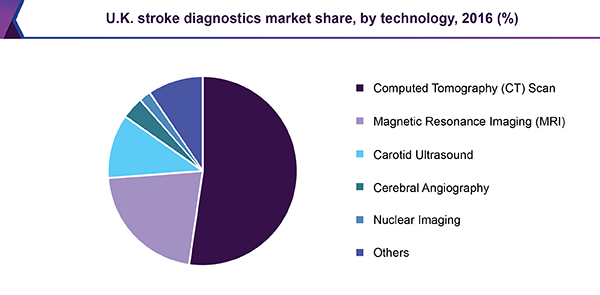- Home
- »
- Clinical Diagnostics
- »
-
North America & Europe Stroke Diagnostics Market Report, 2018-2024GVR Report cover
![North America and Europe Stroke Diagnostics Market Report]()
North America and Europe Stroke Diagnostics Market Analysis Report By Technology (MRI, CT Scan, Carotid Ultrasound, Cerebral Angiography, Nuclear Imaging), And Segment Forecasts, 2018 - 2024
- Report ID: 978-1-68038-954-8
- Number of Report Pages: 66
- Format: PDF, Horizon Databook
- Historical Range: 2013 - 2015
- Forecast Period: 2016 - 2024
- Industry: Healthcare
Industry Insights
The North America and Europe stroke diagnostics market size was valued at USD 1.46 billion in 2016. It is anticipated to witness a CAGR of 6.2% during the forecast period. Stroke is considered as one of the leading causes of mortality and physical disability in North America and Europe. Growing geriatric population is anticipated to propel need for rapid disease diagnosis. According to the Unite Nations (UN) data from 2015, 27% population in Germany is over 60 years of age. This number is projected to grow by 39% by 2050.

Unhealthy lifestyle habits have doubled the risk of stroke. Most notable causes are obesity, physical inactivity, increased pressure at work and in life, and excessive consumption of alcohol and tobacco. Unhealthy diet containing saturated fats, trans-fats, and cholesterol are the noxious factors that can lead to stroke. Prevalence of unhealthy lifestyle is likely to lead to such diseases, which in turn, is expected to fuel market growth in near future.
Increased awareness regarding early manifestations of stroke and its causes is anticipated to positively influence market development over the forecast period. Implementation of smoking cessation by U.S. government and other such initiatives are anticipated to boost demand for stroke diagnostics in near future.
Prevalence of stroke is declining sharply in regions like U.S. France has reported the lowest number of deaths caused by stroke among all the European nations, representing 5.7%, compared to Germany at 6.5% and Italy at 9.7%, in 2013. This drop is also attributed to smoking cessation and availability of better treatment methods for hypertension.
Technology Insights
On the basis of technology, Computed Tomography (CT) scan held the largest share in the North America and Europe stroke diagnostics market in 2016 owing to availability of noninvasive diagnostic techniques and accurate results. Spiral and Multislice CT (MSCT) are the most prominent forms of computed tomography. Spiral CT provides thorough evaluation of body parts along with significant improvement in multiplanar and 3D renderings.
Carotid ultrasound is anticipated to showcase significant growth over the forecast period due to rising usage. Increasing usage can be attributed to its portability, which makes it a primary equipment for emergency medical services. In addition, minimal invasiveness and cost-effectiveness are also anticipated to contribute to segment growth in the forthcoming years.

MRI also contributed to significant revenue in 2016. MRI scanners are majorly preferred after CT scans as they eliminate the use of ionizing radiation and provide more accurate results. This has resulted in increasing use of MRI for the diagnosis of acute ischemic stroke.
Cerebral angiography is also expected to showcase lucrative CAGR over the forecast period. It can be used to detect blockages and abnormal dilation of blood vessels. This type of angiography can also display bleeding sites and detect atherosclerotic abnormalities in the head. Hence, neuroradiologists are anticipated to adopt this technique to form a definitive future diagnostic plan.
Regional Insights
North America dominated the market in 2016 owing to rising unhealthy lifestyle habits. The American Stroke Association states high blood pressure, smoking, diabetes, high blood cholesterol levels, sedentary lifestyles, and lack of exercise as the primary risk factors for stroke among U.S. citizens. Thus, increasing pressure to control stroke rates has given a significant boost to market growth.
Europe held significant market share in 2016 owing to rise in geriatric population. Stroke is the second most common cause of death among Europeans. In the European Union (EU), it caused around 433,000 deaths in 2013. In U.K., around 152,000 cases of stroke are registered a year, states the Stroke Association. Thus, growing number of patients is anticipated to drive demand for stroke diagnostic products in the region.
North America and Europe Stroke Diagnostics Market Share Insights
Some of the leading players in the market are Siemens Healthineers, Hitachi Medical Systems, Cordis Corporation, Boston Scientific Corporation, Neusoft Medical Systems, GE Healthcare, Philips Healthcare, and Toshiba Medical Systems Corporation. Key companies are increasingly engaged in strategic initiatives such as mergers and acquisitions, new product developments, and regional expansions.
For instance, in 2015, Siemens Healthineers launched TwinBeam Dual Energy technology powered SOMATOM CT scanners. In 2016, Medcom GmbH, known for its radiation detection instruments announced its collaboration with Hitachi Medical Systems, Europe. This partnership involves distribution of BiopSee, a fusion imaging system meant to be used in sync with Hitachi ultrasound systems.
Report Scope
Attribute
Details
Base year for estimation
2015
Actual estimates/Historical data
2013 - 2015
Forecast period
2016 - 2024
Market representation
Revenue in USD Million and CAGR from 2016 to 2024
Regional scope
North America, and Europe
Country scope
U.S., Canada, Germany, U.K., France, Italy, Spain
Report coverage
Revenue forecast, company share, competitive landscape, growth factors and trends
15% free customization scope (equivalent to 5 analyst working days)
If you need specific information, which is not currently within the scope of the report, we will provide it to you as a part of customization
Segments Covered in the ReportThis report forecasts revenue growth at regional and country levels and provides an analysis of the latest industry trends in each of the sub-segments from 2013 to 2024. For the purpose of this study, Grand View Research has segmented the North America and Europe stroke diagnostics market report on the basis of technology and region:
-
Technology Outlook (Revenue, USD Million, 2013 - 2024)
-
Computed Tomography (CT) Scan
-
Magnetic Resonance Imaging (MRI)
-
Carotid Ultrasound
-
Cerebral Angiography
-
Nuclear Imaging
-
Others
-
-
Regional Outlook (Revenue, USD Million, 2013 - 2024)
-
North America
-
U.S.
-
Canada
-
-
Europe
-
Germany
-
U.K.
-
France
-
Italy
-
Spain
-
-
Share this report with your colleague or friend.
![gvr icn]()
NEED A CUSTOM REPORT?
We can customize every report - free of charge - including purchasing stand-alone sections or country-level reports, as well as offer affordable discounts for start-ups & universities. Contact us now
![Certified Icon]()
We are GDPR and CCPA compliant! Your transaction & personal information is safe and secure. For more details, please read our privacy policy.
We are committed towards customer satisfaction, and quality service.
"The quality of research they have done for us has been excellent."





